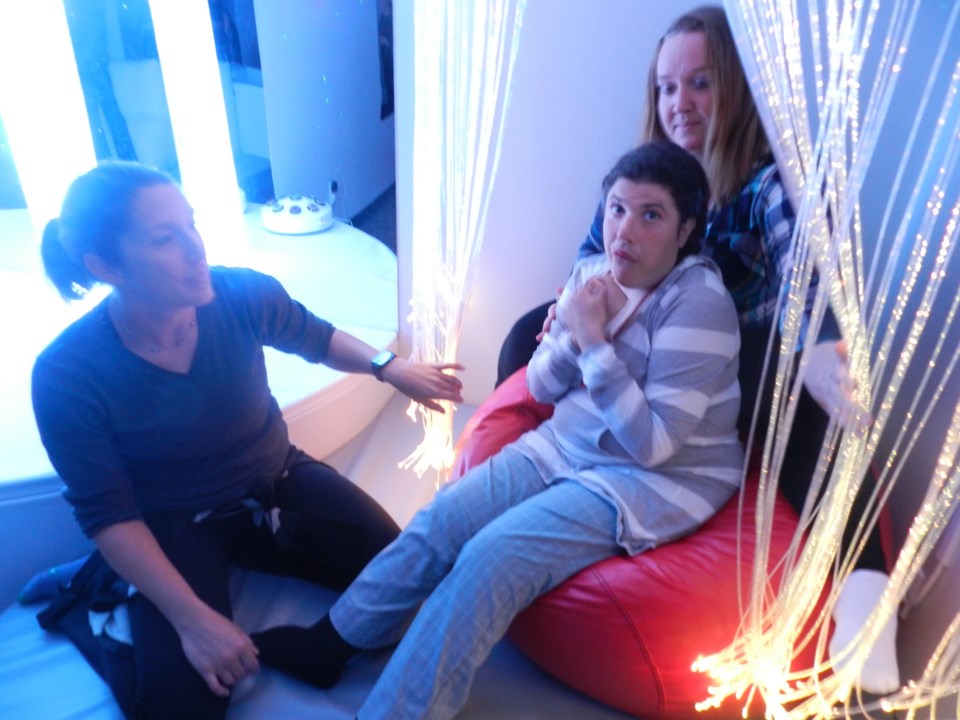The soft glowing lights slowly shift the colours of the walls from a soothing, deep indigo to a warm, autumn red. Meanwhile, bubbles gently gurgle and provide a restful soundtrack as they rise from the bottom of a tall, transparent, water-filled acrylic cylinder.
Welcome to the Snoezelen room at the Richmond Society for Community Living’s (RSCL) facility on Westminster Highway. Tucked away in a narrow but cozy space inside the building, it’s an oasis of calm – the perfect spot where someone, young or old, with a developmental disability, autism or even dementia can experience a beneficial and tailored therapeutic environment.
While the concept has been around since the late 1970s, when Dutch therapists Jan Hulsegge and Ad Verheul experimented with a sensory tent at the DeHartenburg Institute, this is Richmond’s very first facility, and one of just a few in the Lower Mainland.
The term Snoezelen was coined from the contraction of the Dutch verbs “snuffelen” (to seek and explore) and “doezelen” (to relax).
“A room like this can really help somebody to learn how to process their senses in a safe environment,” said Lisa Cowell, who is RSCL’s community development manager.
“They may come in here and start with one piece of stimulation and then add layers as they become more comfortable.”
Using a special lighting system, the walls of the 9x28-foot space, which was formerly used for storage, can be transformed into a variety of colours at the flick of a switch on a wall-mounted control panel.
Plus, there is a variety of tactile experiences, from a small, lighted ball-pit users can plunge into, to a flowing curtain of LED lights surrounding a comfy bean bag cushion
“The room allows everyone to have their own, unique experience,” said Jessica Hamm, an infant development consultant with RSCL. “We serve more than 1,100 people and each has their own sensory needs, from calmer to more stimulating.”
For example, someone who has autism, dealing with varying levels of sensory stimulation in the world around them can be a challenge, Cowell said.
“Things can certainly be overwhelming for someone who processes their senses in a different way.”
On the other end of the scale, the Snoezelen room can also provide increased levels of stimulation.
“In those cases, the individual maybe has difficulty in speaking, may use a wheelchair or have other physical limitations,” Cowell said. “And a room like this can really help caregivers or other people to learn how to read a person’s happiness, their desires. That can be useful for their life in the community where they can be better understood.”
Typical sessions in the room run from 30 minutes to two hours.
“The first thing that you see most of the time from users is that they are drawn to one thing in the room. Then it’s vocalization of what they enjoy,” Hamm said.
“One fellow who came in jumped right into the ball-pit and covered himself in the balls, except for his eyes so he could see what we were doing. And I could hear him say, ‘This is so nice, I am so happy here.’
“There’s this instant relaxation that happens.”
The room was completed in late spring. Cost of developing and equipping it was $35,000.
“For us, it was a bit of a dream to have it and we didn’t know how to get it started,” Cowell said.
But, while hosting a Richmond Chamber of Commerce event at the RSCL’s facility when the Snoezelen room was still just an idea, a local architect, Rosa Salcido Rosa Salcido, of Vivid Green Architecture, who was among those in the visiting group, said she had designed other Snoezelen rooms and said she’d be keen to donate her services to get one fitted into the former storage room space.
With that assistance in place, RSCL went about fundraising at its annual gala, since a facility of this type is not eligible for government funding.
“For us to be able to offer this room for 1,100 Richmondites is amazing,” Cowell added.



